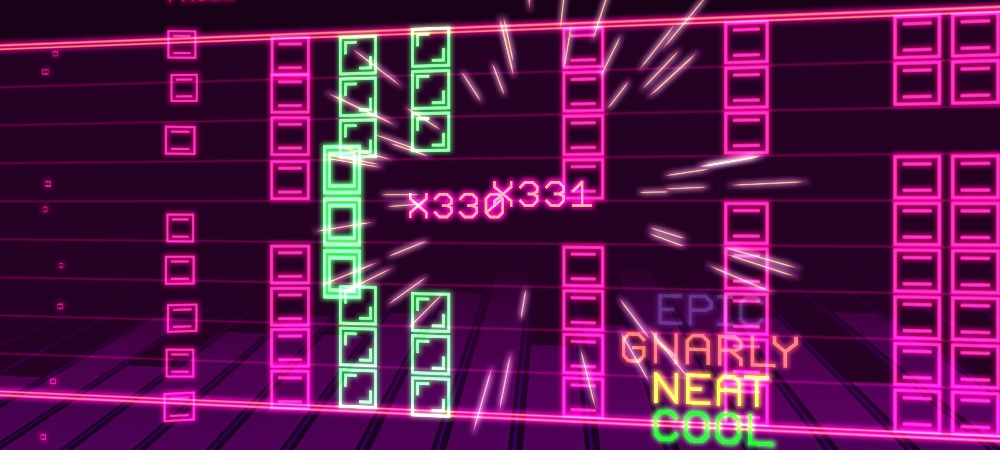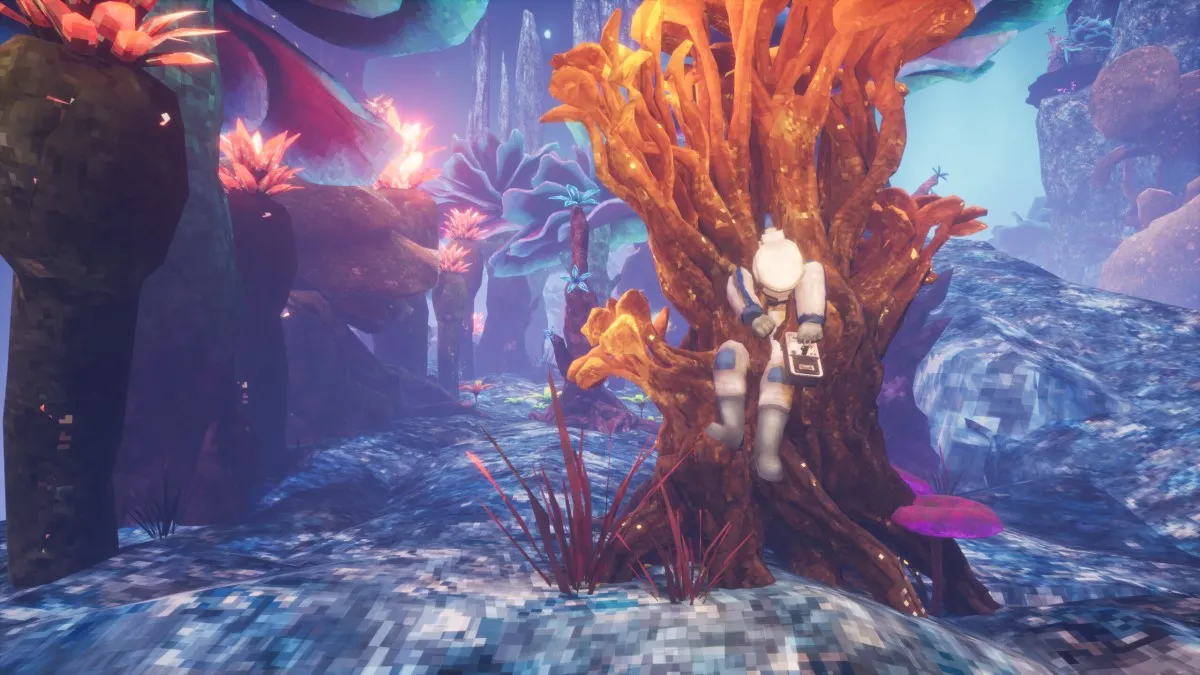Fits like a glove
Simple graphics, twitch gameplay, and fresh music constitute a good formula for mobile gaming. Titles like this allow for a quick bit of play during minutes of downtime, and can paradoxically keep players going for long periods of time, chasing a high score or trying to one-up a friend on the leaderboards.
Size DOES Matter follows in that legacy, with a unique gameplay hook and a pretty killer soundtrack. However, a few things hold it back from pure arcade bliss.

Size DOES Matter (Android [reviewed], iPad, iPhone)
Developer: DOS Studios
Publisher: Channel 4
Release: August 13, 2014 (iOS), August 22, 2014 (Android)
MSRP: $1.64 (Android), $0.99 (iOS)
At first, Size DOES Matter looks like another in the long line of Flappy Bird clones and spinoffs, but it quickly reveals that it has more to it than just that. The player controls a floating string of blocks in an attempt to make it pass through gates without colliding into surrounding pillars.
The twist alluded to in the game’s title is that the string of blocks and the passageways can both exist in one of three sizes: one block tall, three blocks tall, and five blocks tall. Passing through a gate successfully involves not only making it through without hitting the sides, but also cutting it as close as possible by matching the block size with the gate size perfectly.
While that is simple enough in concept, the additional layer injects a sort of “rubbing one’s belly while patting one’s head” feeling to it, where the brain has trouble processing position and size separately. Beginning players will often grow the chain when they wanted to move it or vice versa.
Once the basics are mastered, Size DOES Matter really opens up to show its strengths. The scoring and progression mechanisms hold within them an interesting risk/reward strategy decision. Each successful navigation through a gate awards points and increases the multiplier by one. Unsuccessful passes come in two varieties: going through in a size smaller than that of the gate awards no points and adds nothing to the multiplier, but crashing into a wall resets the multiplier back down to one.
The result is that on tough sections, it is often wiser to shrink down to one block even on three- or five-block high gates, in order to regain composure and get through without losing a big multiplier. Most of the high scores required to advance can be achieved by skipping entire sections of gates, as long as the multiplier is preserved.
However, every song has three difficulties, each played one after the other, but players may only advance to the next difficulty if they have made fewer than three mistakes total. Mistakes include collisions and passing through while smaller than required, so near perfection is required to move on to the higher difficulties. Of course, the higher difficulties feature more gates that advance more quickly, offering much more opportunity for achieving super high scores.

One of the problems that turns up is that it is very rare for one mistake to be just one mistake. Generally, if the player moves up when he should have moved down or changed size, or grows when he should have moved or shrunk, he is now in a position two removed from where he needs to be in order to successfully hit the following gate. Considering several can hit per second, and some even simultaneously, it is a rare occasion that one mistake is limited to just that.
This is compounded by the controls, which work very well most of the time, but fail spectacularly on occasion. The default control has player swiping the left side of the screen to move and the right side of the screen to change size. The act of swiping ends up taking too much time when things get fast, so an alternate mode allows players to tap in one of four quadrants for the same results. Without tactile feedback, thumbs will sometimes stray too far from where they should be and players will grow when they meant to shrink, or worse if playing on Android, hit the soft buttons for home or back. Those should be hidden in a game like this, but what would really perfect the controls would be a traditional D-pad and buttons.
As players progress through the track list, another aspect of Size DOES Matter‘s gameplay reveals itself. Where early on it plays like a twitch arcade game set to music, later levels show that it is actually a rhythm game. The blocks pass through the gates to the beat of the music, but a beginner will always make adjustments between gates and between beats. As it turns out, commands to move, grow, and shrink can be (and in later levels, must be) input as soon as the blocks are inside a gate. In other words, high-level play requires swiping and tapping to the beat.
At some point, it all clicks into place. In the beginning, a player will be consciously thinking about executing the next move, but soon enough the pace picks up to the point where that is not possible. And then, after feeling like a wall has been hit and no more progress can be made, the player’s fingers and eyes will circumvent his pesky brain that has been slowing them down, and he will get through a tricky section unscathed without really knowing how.

This gaming nirvana can get a player through to the last stage, but at that point (or on the highest difficulty runs on easier stages), the magic wears off. At some point, it just becomes too fast and its telegraphs too muddled to work. At that point, high scores can only be achieved by rote learning. Since each level has been crafted to match the song and there is no bit of procedural generation in play, it all becomes much less interesting at this point.
Still, there is a lot to be said about how well the presentation works in Size DOES Matter‘s favor. The crisp graphics help to enhance a player’s ability to succeed, where differently sized gates have distinct colors and designs, making them easily recognizable even when on the periphery. Special attention was paid to the soundtrack, which features some great tunes by Eirik Suhrke (Spelunky), Savant (Savant: Ascent), Chipzel (Super Hexagon), and others. The soundtrack alone is worth the price for the full game.
Size DOES Matter takes willing players on a journey. It begins as a lesson in coordination both between hand and eye and between two separate thought processes. As it progresses, it becomes a rhythm game requiring utmost attention. Then, players hit a sort of enlightened state where everything seems to move slowly and fingers do what they should without being told. After that, it is mostly an exercise in memorization and frustration. Some may never get that far, but most would benefit from trying.





Published: Sep 15, 2014 03:00 pm